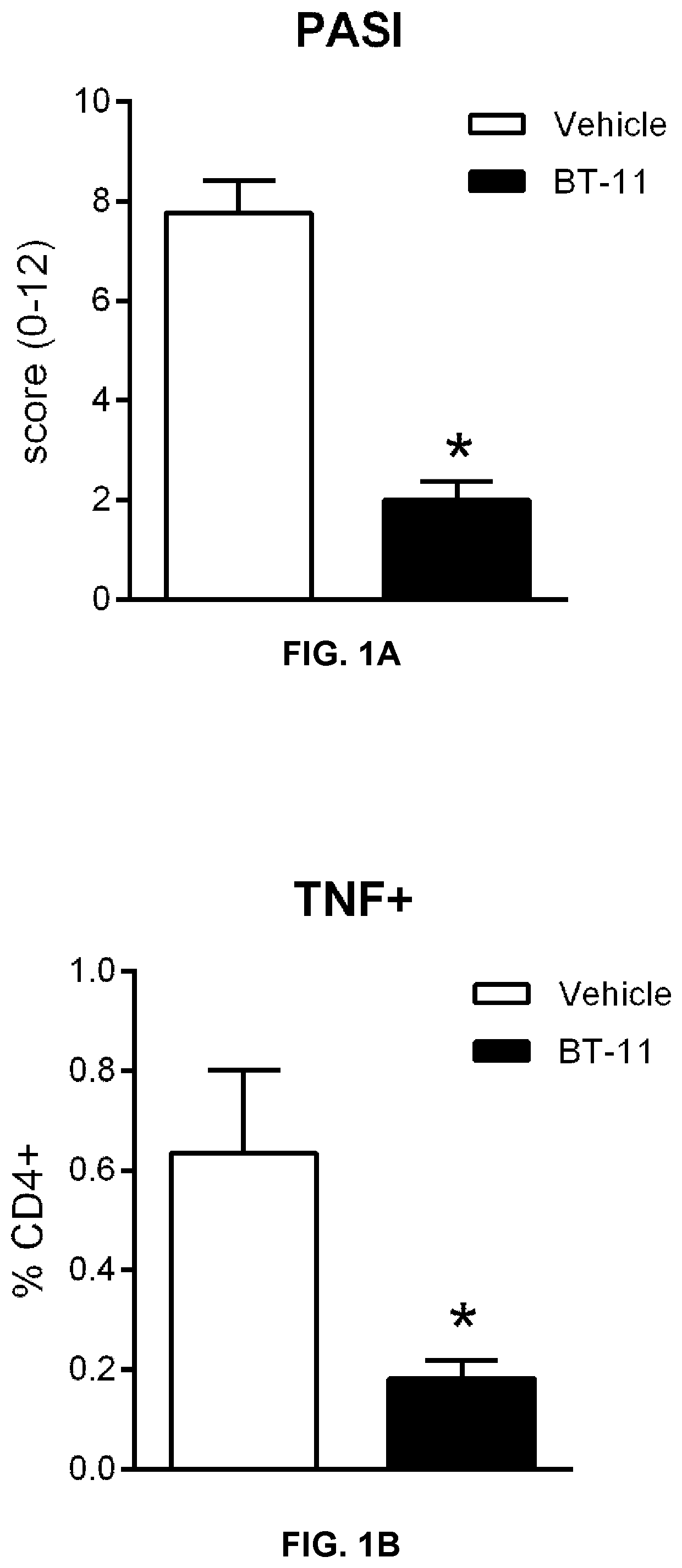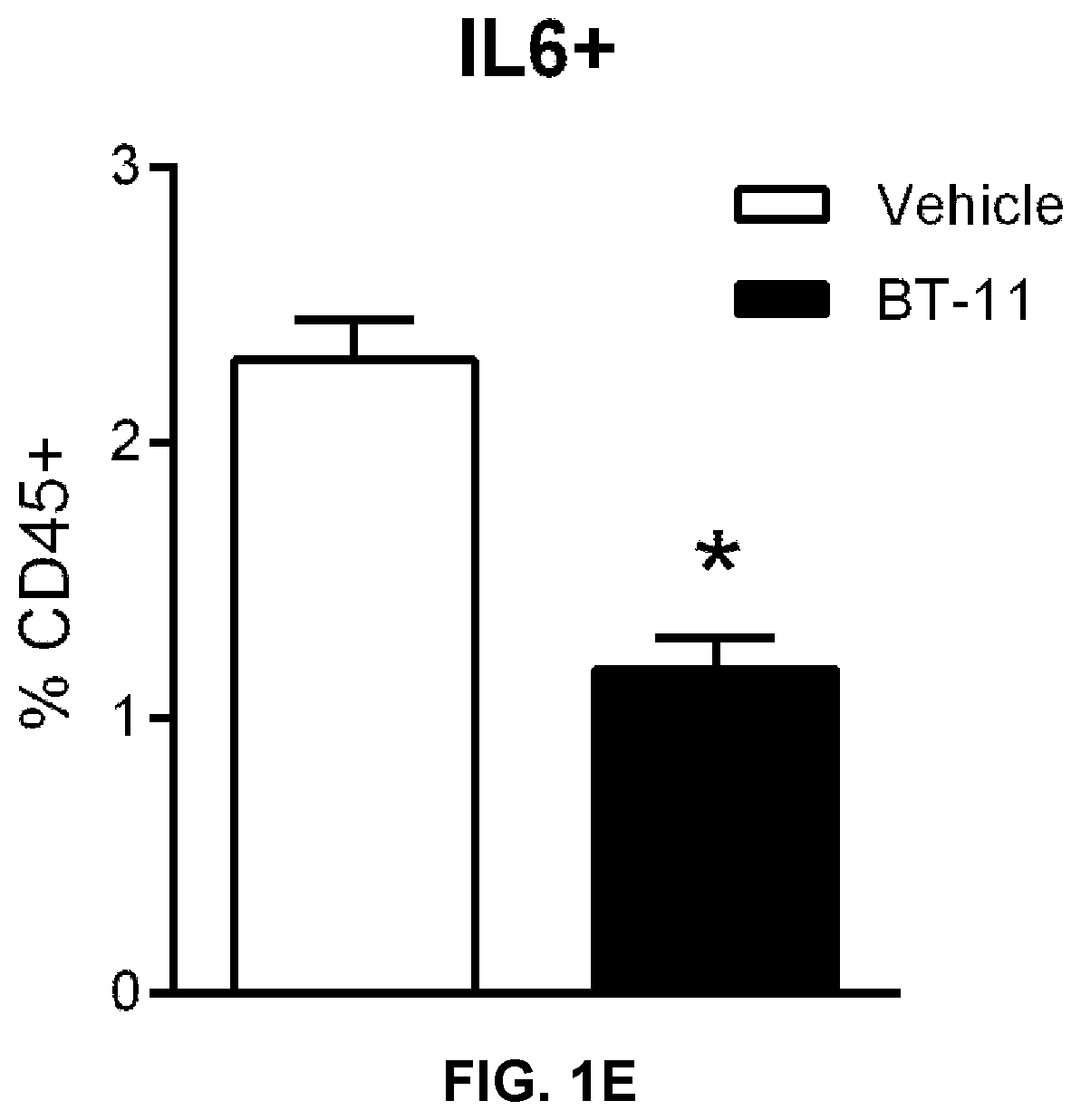Compounds, compositions, and methods for treating inflammatory or immune-mediated conditions of surface tissues
a technology of surface tissues and compositions, applied in the field of compounded compositions and methods for treating inflammatory or immune-mediated conditions of surface tissues, can solve the problems of dermatological side effects, steroid allergy, and steroid loss effectiveness
- Summary
- Abstract
- Description
- Claims
- Application Information
AI Technical Summary
Benefits of technology
Problems solved by technology
Method used
Image
Examples
example 1
pical BT-11 Dihydrochloride Salt in a Model of Psoriasis
Introduction
[0167]Psoriasis afflicts over 7 million people in the United States and 15 million worldwide, with over 95 million worldwide afflicted by inflammatory skin diseases, inclusive of psoriasis, atopic dermatitis, and rosacea. The resultant itchiness, effects on appearance, and persistent rashes have a significant impact on quality of life. In psoriasis, the most successful therapies have targeted Th17 cells and the IL-17 / IL-23 axis. As such, demonstrating the ability of novel therapeutics to impact the differentiation of these cells, in vivo, is a critical mechanistic finding. Importantly, impacting Th17 / Treg plasticity may indicate a mechanistic avenue for the maintenance of clinical responses by establishing a tolerogenic environment. Meanwhile, Th17 cells are believed to be the most responsive to metabolic manipulation, suggesting a susceptibility to the immunometabolic effects of the LANCL2 pathway.
Methods
[0168]Imiq...
example 2
Topical BT-11 Dihydrochloride Cream
[0171]Topical cream formulations containing BT-11 dihydrochloride (Formulation 1 and Formulation 2) were generated. The formulations are shown in Tables 1 and 2. The characterization of the prepared creams is shown in Table 3.
TABLE 1Exemplary topical BT-11 dihydrochloride cream formulations.Concentration (% w / w)IngredientFunctionalityFormulation 1Formulation 2BT-11Active Ingredient33Propylene GlycolHumectant / Vehicle2027White PetrolatumEmollient / Thickener1210Stearyl AlcoholEmulsion Stabilizer / 1210ThickenerGlycerylEmulsifying52.5MonostearateAgent / ThickenerSpan 20Emulsifying Agent0.50.5Tween 80Emulsifying Agent4.54.5WaterCarrier4842.5100100
TABLE 2Exemplary topical BT-11 dihydrochloride cream formulations.Conceitration (% w / w)IngredientFunctionalityF3F4F5F6F7F8F9F10F11BT-11Active Ingredient20.520.522234Propylene GycolHumectant / Vehicle2828.62626.62626262728.6White PetrolatumEmollient / Thickener101010101010101110Stearyl AlcoholEmulsion Stabilizer / 10101010...
example 3
pical BT-11 Dihydrochloride Cream in a Model of Atopic Dermatitis
Introduction
[0172]Atopic dermatitis affects 10 to 20% of children and 1 to 3% of adults, with over 95 million worldwide afflicted by inflammatory skin diseases, inclusive of psoriasis, atopic dermatitis, and rosacea. The resultant itchiness, effects on appearance, and persistent rashes have a significant impact on quality of life. In atopic dermatitis, the immunological pathogenesis is often attributed to type 2 immune responses, which are commonly associated with a variety of allergic diseases. Type 2 immunes responses are driven in part by increased production of IL-4 and IL-5 cytokines.
Methods
[0173]MC903-induced model. MC903 (2 nM in 20 uL ethanol) was applied to the dorsal ear skin three times per week for nine applications. BT-11 topical cream (2%) (Formula F3 is Table 2) was applied to the ear daily. Mice were scored for erythema, scaling and skin thickness, summarized into a composite disease activity index scor...
PUM
| Property | Measurement | Unit |
|---|---|---|
| structure | aaaaa | aaaaa |
| Stability | aaaaa | aaaaa |
| weight | aaaaa | aaaaa |
Abstract
Description
Claims
Application Information
 Login to View More
Login to View More - R&D
- Intellectual Property
- Life Sciences
- Materials
- Tech Scout
- Unparalleled Data Quality
- Higher Quality Content
- 60% Fewer Hallucinations
Browse by: Latest US Patents, China's latest patents, Technical Efficacy Thesaurus, Application Domain, Technology Topic, Popular Technical Reports.
© 2025 PatSnap. All rights reserved.Legal|Privacy policy|Modern Slavery Act Transparency Statement|Sitemap|About US| Contact US: help@patsnap.com



